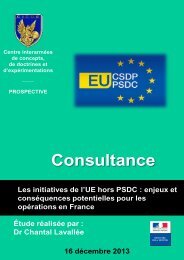Conference
science-research-bulletin-2013-conference
science-research-bulletin-2013-conference
You also want an ePaper? Increase the reach of your titles
YUMPU automatically turns print PDFs into web optimized ePapers that Google loves.
EUROPEAN POLICE SCIENCE AND RESEARCH BULLETIN<br />
SPECIAL CONFERENCE EDITION<br />
availability of what looks like very immediate<br />
information at a low cost. This is against a<br />
background in which not only are budgets<br />
under pressure, but the inherent costs of data<br />
collection and analysis, and of information<br />
assurance, have historically tended to rise. The<br />
sociologist George Homans said in 1974 ‘The<br />
methods of social science are dear in time and<br />
money and getting dearer every day’ (cited in<br />
Goulder 2010). Now, in Vint Cerf’s words, ‘We<br />
never, ever, in the history of mankind have had<br />
access to so much information so quickly and so<br />
easily’ (cited in Boyd 2010).<br />
Danah boyd reminds us that what gets lost in<br />
this excitement is a critical analysis of what this<br />
data is and what it means (boyd 2010). She raises<br />
five cautionary points about the limits of big<br />
data as a research tool. Although Boyd does not<br />
consider the application to policing, these are of<br />
particular concern in trying to use social media<br />
data as a basis for predictions of large scale<br />
social behaviour, such as crime trends or possible<br />
hotspots for disorder.<br />
Boyd’s first point is that ‘Bigger Data are Not<br />
Always Better Data’. Big Data isn’t always a whole<br />
data set. Twitter has all of Twitter. But most<br />
researchers don’t have all of Twitter. At best,<br />
they have access to the set of public tweets. It<br />
is more likely though that they have the stream<br />
of public tweets from the public timeline. These<br />
tweets aren’t even random, nor is it apparent,<br />
what selection processes are actually at work in<br />
the creation of the sample.<br />
The second is that ‘Not All Data are Created<br />
Equal’. Big Data introduces two new popular<br />
types of social networks derived from data traces:<br />
articulated social networks and behavioural<br />
social networks. Articulated networks are those<br />
that result from the typically public articulation<br />
of social networks as in the public list of people’s<br />
Friends on Facebook. Behavioural networks are<br />
those that are derived from communication<br />
patterns and cell coordinates. Each of these<br />
networks is extraordinarily interesting, but they<br />
are not the same as what sociologists have<br />
historically measured or theorised in discussing<br />
social networks.<br />
Boyd goes on to remind us that ‘What and<br />
Why are Different Questions’, in other words<br />
why people do what they do online cannot<br />
be read from what they do in any simple way.<br />
Hence it is also necessary to ‘Be Careful of Your<br />
Interpretations’. Finally, she advises that ‘Just<br />
Because [the data] is Accessible Doesn’t Mean<br />
Using It is Ethical’. This is of particular concern for<br />
law enforcement authorities and takes us back to<br />
the discussion about authorisation.<br />
In other words, social media aren’t as easy to<br />
exploit as may have been hoped, and some<br />
kind of operational benefits are unlikely to be<br />
straightforward to realise. The COSMOS project,<br />
based at Cardiff University, identifies four issues<br />
in particular for the police. Dealing with these<br />
is a current challenge for computer scientists<br />
and social scientists alike who are working on<br />
police data sets. The project has highlighted the<br />
problems for researchers of handling material<br />
in bulk. COSMOS archives and collects 350<br />
million tweets per day (1 % total). Data from<br />
social media often comes with a relative lack of<br />
metadata, such as information about location<br />
or the identity of the author. The content may<br />
provide no easy means of distinguishing rumour<br />
from useful intelligence (although this is not a<br />
unique problem for social media data). Finally,<br />
and perhaps fundamentally, the reciprocity<br />
between online expression and offline action is<br />
still largely not understood. Further investigation<br />
is necessary before full advantage can be taken<br />
of the new digital tools of ‘neighbourhood<br />
informatics’.<br />
In their analysis of social media use during the<br />
2012 Olympics, COSMOS concludes that not just<br />
real world events (such as UK gold medal wins)<br />
but also media comments about those events<br />
drove peaks in tweeting about games. This has<br />
led to the conclusion that the results achieved<br />
through this kind of research ‘provides the means<br />
of beginning to treat social media data (and its<br />
analysis) as a social scientific measure of the pulse<br />
of the world’ (Burnap et al. 2012)<br />
In a recent paper in the international journal<br />
Policing and Society, Martin L Williams et al.<br />
(2013) from the COSMOS project have looked<br />
to apply this approach to the way that police<br />
forces in the UK to assess tension i.e. potential<br />
civil unrest and public order issues. They argue<br />
that the 2011 riots demonstrated the existence<br />
of what they describe as cyber-neighbourhoods<br />
but that the police had only limited success in<br />
collecting and using intelligence from these new<br />
neighbourhoods. To do so successfully requires<br />
bespoke tools which can be measured against<br />
existing sources of intelligence.<br />
109





